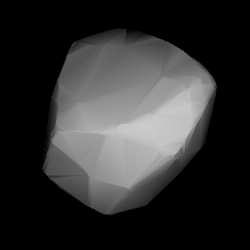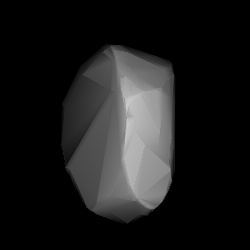Related Research Articles
1982 Cline, provisional designation 1975 VA, is a stony asteroid from the inner regions of the asteroid belt, approximately 8 kilometers in diameter. It was discovered on 4 November 1975, by American astronomer Eleanor Helin at Palomar Observatory in California, and named after Edwin Lee Cline, inventor and friend of the discoverer.
1018 Arnolda, provisional designation 1924 QM, is a stony asteroid from the central regions of the asteroid belt, approximately 16 kilometers in diameter. It was discovered on 3 March 1924, by German astronomer Karl Reinmuth at the Heidelberg-Königstuhl State Observatory in southwest Germany. The asteroid was named after physicist Arnold Berliner.
1033 Simona, provisional designation 1924 SM, is a stony Eoan asteroid from the outer regions of the asteroid belt, approximately 20 kilometers in diameter. The asteroid was discovered by George Van Biesbroeck in 1924, who named it after his daughter Simona.
1142 Aetolia, provisional designation 1930 BC, is a stony background asteroid from the outer region of the asteroid belt, approximately 24 kilometers in diameter. It was discovered on 24 January 1930, by German astronomer Karl Reinmuth at the Heidelberg-Königstuhl State Observatory and named for the Greek region Aetolia.
1113 Katja, provisional designation 1928 QC, is a background asteroid from the outer regions of the asteroid belt, approximately 39 kilometers in diameter. It was discovered by Pelageya Shajn at the Simeiz Observatory in 1928, and named after Ekaterina Iosko, a staff member at the discovering observatory.
1123 Shapleya, provisional designation 1928 ST, is a stony Florian asteroid from the inner regions of the asteroid belt, approximately 11 kilometers in diameter. It was discovered on 21 September 1928, by Russian astronomer Grigory Neujmin at Simeiz Observatory on the Crimean peninsula. It was named after American astronomer Harlow Shapley.

1132 Hollandia, provisional designation 1929 RB1, is a stony asteroid from the middle region of the asteroid belt, approximately 27 kilometers in diameter. It was discovered on 13 September 1929, by Dutch astronomer Hendrik van Gent at Leiden Southern Station, annex to the Johannesburg Observatory in South Africa. It was named for the region Holland in the Netherlands.

1147 Stavropolis is a stony background asteroid from the inner regions of the asteroid belt. It was discovered on 11 June 1929, by Georgian–Russian astronomer Grigory Neujmin at the Simeiz Observatory on the Crimean peninsula. The S-type asteroid has a rotation period of 5.7 hours and measures approximately 14 kilometers in diameter. It was named after the Russian city of Stavropol.

1457 Ankara, provisional designation 1937 PA, is a stony asteroid from the central region of the asteroid belt, approximately 18 kilometers in diameter. It was discovered on 3 August 1937, by German astronomer Karl Reinmuth at Heidelberg Observatory in southwest Germany, and later named for the Turkish capital city of Ankara.
3724 Annenskij, provisional designation 1979 YN8, is a stony Gefionian asteroid from the central regions of the asteroid belt, approximately 14 kilometers (9 miles) in diameter. It was discovered on 23 December 1979, by Soviet astronomer Lyudmila Zhuravleva at the Crimean Astrophysical Observatory in Nauchnij, on the Crimean peninsula. The S-type asteroid has a rotation period of 3.97 hours. It was named for Russian poet Innokenty Annensky.

1274 Delportia, provisional designation 1932 WC, is a stony Florian asteroid from the inner regions of the asteroid belt, approximately 10 kilometers in diameter. It was discovered on 28 November 1932, by Belgian astronomer Eugène Delporte at Uccle Observatory in Belgium. It was named after the discoverer himself.
1806 Derice, provisional designation 1971 LC, is a stony Flora asteroid from the inner regions of the asteroid belt, approximately 10 kilometers in diameter. Discovered on 13 June 1971, at the Bickley site of the Perth Observatory in Western Australia, it was the first discovery of a minor planet ever made in Oceania. The asteroid was named after the wife of Dennis Harwood, staff member at Bickley.
1736 Floirac, provisional designation 1967 RA, is a stony Florian asteroid from the inner regions of the asteroid belt, approximately 8.7 kilometer in diameter.
3700 Geowilliams, provisional designation 1984 UL2, is a stony background asteroid from the inner regions of the asteroid belt, approximately 8 kilometers (5 miles) in diameter. It was discovered on 23 October 1984, by American astronomer couple Carolyn and Eugene Shoemaker at the Palomar Observatory in California, United States. The S k-subtype has a rotation period of 14.38 hours. It was named for Australian geologist George E. Williams.
3066 McFadden, provisional designation 1984 EO, is a stony background asteroid from the central regions of the asteroid belt, approximately 15 kilometers in diameter. It was discovered on 1 March 1984, by American astronomer Edward Bowell at the Anderson Mesa Station near Tucson, Arizona. It was named for American planetary scientist Lucy-Ann McFadden. The assumed S-type asteroid has a rotation period of 13.8 hours.
2122 Pyatiletka, provisional designation 1971 XB, is a stony asteroid from the inner regions of the asteroid belt, approximately 11 kilometers in diameter.

2111 Tselina is a stony Eos asteroid from the outer regions of the asteroid belt. It was discovered on 13 June 1969, by Soviet astronomer Tamara Smirnova at Crimean Astrophysical Observatory in Nauchnij, on the Crimean peninsula. The S-type asteroid has a rotation period of 6.6 hours and measures approximately 23 kilometers in diameter. It was later named after the Soviet Virgin Lands Campaign.
1447 Utra, provisional designation 1938 BB, is a stony asteroid, slow rotator and suspected tumbler from the central region of the asteroid belt, approximately 12 kilometers in diameter. It was discovered on 26 January 1938, by Finnish astronomer Yrjö Väisälä at Turku Observatory in Southwest Finland. The asteroid was named for the Finnish town of Utra.
1451 Granö, provisional designation 1938 DT, is a stony Florian asteroid and slow rotator from the inner regions of the asteroid belt, approximately 6.5 kilometers in diameter. It was discovered on 22 February 1938, by Finnish astronomer Yrjö Väisälä at Turku Observatory in Southwest Finland, and later named for Johannes Gabriel Granö, rector of the University of Turku.
1887 Virton, provisional designation 1950 TD, is a stony Eoan asteroid from the outer region of the asteroid belt, approximately 21 kilometers in diameter. It was discovered by Belgian astronomer Sylvain Arend at the Royal Observatory of Belgium in Uccle on 5 October 1950, and named after the Belgian town of Virton.
References
- 1 2 3 4 5 6 "JPL Small-Body Database Browser: 2433 Sootiyo (1981 GJ)" (2017-03-05 last obs.). Jet Propulsion Laboratory . Retrieved 13 June 2017.
- 1 2 3 Schmadel, Lutz D. (2007). "(2433) Sootiyo". Dictionary of Minor Planet Names – (2433) Sootiyo. Springer Berlin Heidelberg. p. 198. doi:10.1007/978-3-540-29925-7_2434. ISBN 978-3-540-00238-3.
- 1 2 3 4 5 6 "LCDB Data for (2433) Sootiyo". Asteroid Lightcurve Database (LCDB). Retrieved 1 September 2016.
- 1 2 3 Masiero, Joseph R.; Grav, T.; Mainzer, A. K.; Nugent, C. R.; Bauer, J. M.; Stevenson, R.; et al. (August 2014). "Main-belt Asteroids with WISE/NEOWISE: Near-infrared Albedos". The Astrophysical Journal. 791 (2): 11. arXiv: 1406.6645 . Bibcode:2014ApJ...791..121M. doi:10.1088/0004-637X/791/2/121 . Retrieved 1 September 2016.
- 1 2 3 4 Mainzer, A.; Grav, T.; Masiero, J.; Hand, E.; Bauer, J.; Tholen, D.; et al. (November 2011). "NEOWISE Studies of Spectrophotometrically Classified Asteroids: Preliminary Results". The Astrophysical Journal. 741 (2): 25. arXiv: 1109.6407 . Bibcode:2011ApJ...741...90M. doi:10.1088/0004-637X/741/2/90.
- 1 2 3 4 Usui, Fumihiko; Kuroda, Daisuke; Müller, Thomas G.; Hasegawa, Sunao; Ishiguro, Masateru; Ootsubo, Takafumi; et al. (October 2011). "Asteroid Catalog Using Akari: AKARI/IRC Mid-Infrared Asteroid Survey". Publications of the Astronomical Society of Japan. 63 (5): 1117–1138. Bibcode:2011PASJ...63.1117U. doi: 10.1093/pasj/63.5.1117 . (online, AcuA catalog p. 153)
- 1 2 Angeli, C. A.; Guimarã; es, T. A.; Lazzaro, D.; Duffard, R.; Fernández, S.; et al. (April 2001). "Rotation Periods for Small Main-Belt Asteroids From CCD Photometry". The Astronomical Journal. 121 (4): 2245–2252. Bibcode:2001AJ....121.2245A. doi: 10.1086/319936 . Retrieved 1 September 2016.
- ↑ Behrend, Raoul. "Asteroids and comets rotation curves – (2433) Sootiyo". Geneva Observatory . Retrieved 1 September 2016.
- 1 2 3 Veres, Peter; Jedicke, Robert; Fitzsimmons, Alan; Denneau, Larry; Granvik, Mikael; Bolin, Bryce; et al. (November 2015). "Absolute magnitudes and slope parameters for 250,000 asteroids observed by Pan-STARRS PS1 – Preliminary results". Icarus. 261: 34–47. arXiv: 1506.00762 . Bibcode:2015Icar..261...34V. doi:10.1016/j.icarus.2015.08.007 . Retrieved 1 September 2016.
- 1 2 "2433 Sootiyo (1981 GJ)". Minor Planet Center. Retrieved 1 September 2016.
- ↑ "MPC/MPO/MPS Archive". Minor Planet Center. Retrieved 1 September 2016.